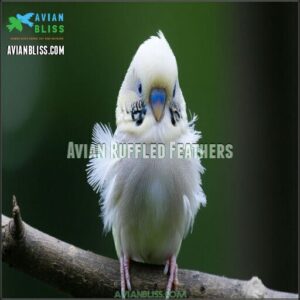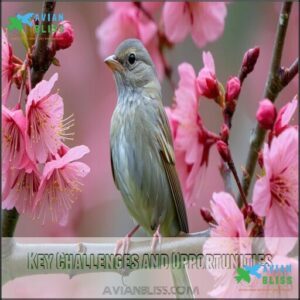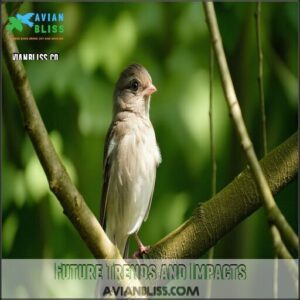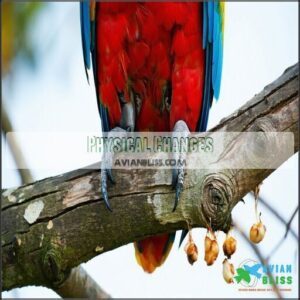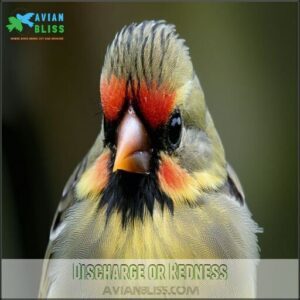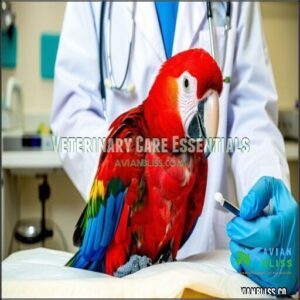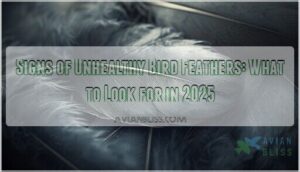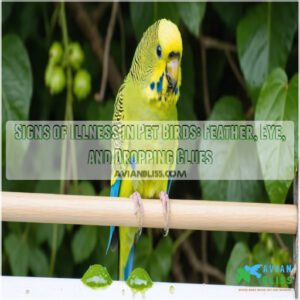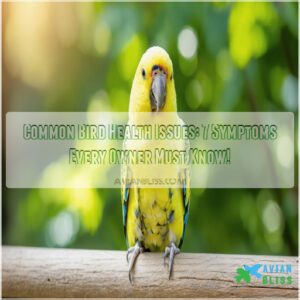This site is supported by our readers. We may earn a commission, at no cost to you, if you purchase through links.
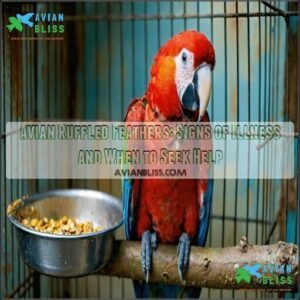
Watch for other signs like puffed-up feathers, lethargy, odd breathing, or a drooping posture. These changes can point to underlying problems such as respiratory issues, infections, or nutritional deficiencies.
Sometimes stress or poor habitat conditions play a role too. Birds also use their feathers to express health, so dull or broken feathers need attention.
Make certain your bird gets clean surroundings, a balanced diet, and regular vet visits. Spotting problems early can make all the difference. Curious how to keep your feathered friend thriving? Stay tuned!
Table Of Contents
- Key Takeaways
- Avian Ruffled Feathers
- Causes of Ruffled Feathers
- Health Issues Indicators
- Veterinary Care Essentials
- Preventing Avian Illness
- Frequently Asked Questions (FAQs)
- What does it mean when my bird’s feathers are ruffled?
- What are the symptoms of Pacheco’s disease in birds?
- What causes ruffled feathers in poultry?
- What are the symptoms of avian polyomavirus?
- How do weather changes affect feather health?
- Can avian medications impact feather condition or growth?
- How do social environments influence feather maintenance habits?
- What role does hydration play in feather quality?
- Are certain bird species more prone to feather issues?
- Conclusion
Key Takeaways
- Pay attention to your bird’s ruffled feathers, as they might signal illness, stress, or poor nutrition. Watch for other signs like lethargy or breathing issues.
- Keep your bird’s environment clean and their diet balanced to prevent health problems and support vibrant, healthy feathers.
- Early signs of illness include discharge, feather loss, or changes in droppings. Consult an avian vet promptly if you spot these.
- Regular vet check-ups and monitoring help catch and treat potential health issues before they become serious.
Avian Ruffled Feathers
Ruffled feathers in birds can be an early sign of illness or stress, making it important to pay attention to their appearance.
Ruffled feathers often reveal hidden stress or illness—observe closely to ensure your feathered companion stays healthy and happy.
Changes like feathers looking dull, uneven, or misaligned often point to underlying health issues that require timely care.
Signs of Illness
Spotting signs of illness in birds starts with observing behavior.
Lethargy, appetite changes, and wing tremors are key sick bird signs.
Droppings analysis helps reveal hidden issues.
Watch for avian ruffled feathers as they often signal illness, like stress or malnutrition.
Balance issues or unusual movements are unhealthy bird signs.
Early action prevents worsening bird illness symptoms, and it is crucial for maintaining the bird’s health, which can be indicated by avarian ruffled feathers.
Respiratory Issues
Ruffled feathers can signal respiratory issues in birds.
Watch for breathing difficulty, nasal discharge, or sinusitis symptoms. Respiratory infections, fungal infections, and avian influenza are common avian health problems.
Look out for these sick bird signs:
- Open-mouthed breathing at rest.
- Tail bobbing or labored breathing.
- Crusted nasal discharge.
- Lethargy with persistent ruffled feathers.
Seek veterinary care immediately, especially if you notice lethargy, as it can be a sign of a serious underlying condition.
Feather Plucking
Feather plucking often stems from stress, boredom, or underlying medical issues.
This destructive behavior can escalate from mild preening to serious stress behaviors like self-mutilation.
Address plucking causes with veterinary interventions and behavioral solutions.
Promote feather regrowth by creating a stress-free environment and providing environmental enrichment.
Understanding the role of emotional stressors can help tailor effective interventions.
Gradually implementing changes reduces behavioral changes and supports feather health while ensuring your bird feels safe and secure.
Poor Nutrition
A poor diet can leave your bird with dull, brittle feathers and lower energy.
Nutritional deficiencies, like vitamin A depletion or calcium shortages, often stem from all-seed diets.
Balanced bird nutrition includes protein sources, calcium intake, and omega-3-rich foods.
Without these, mineral imbalances arise, weakening feather health.
Address vitamin deficiencies by adding greens and fruits for vibrant feathers and stronger birds.
Causes of Ruffled Feathers
Ruffled feathers in birds can result from stress, illness, poor nutrition, or environmental factors. Understanding these causes helps you spot potential issues early and keep your feathered friend healthy.
Understanding The Subtopic Purpose
Understanding bird ruffled plumage helps uncover health clues.
Feathers aren’t just for looks—they’re essential for insulation, flight, and protection.
Early detection of feather abnormalities reveals issues like infections or nutrition gaps.
Unhealthy bird feathers signal illness, making avian veterinary care key.
Prevention focuses on the bird’s needs, while veterinary roles guarantee proper care and solutions for avian ruffled feathers illness, which is crucial for the bird’s overall health clues.
Key Challenges And Opportunities
Bird health can be tricky to diagnose due to limited tools and research funding.
Ruffled feathers disease, diagnostic limitations, and treatment accessibility remain challenges. Feather abnormalities signal health issues, but proactive prevention helps.
Public awareness of avian ruffled feathers encourages better care. Investing in avian veterinary care and research reveals solutions for bird ruffled plumage and improves overall well-being.
Future Trends And Impacts
What’s next for understanding avian ruffled feathers illness? Diagnostic advancements will help avian veterinarians pinpoint issues faster, while treatment innovations improve care.
Research directions focus on bird health and prevention. Preventative strategies tackle environmental impacts, reducing stress and disease.
Birds often use feather fluffing for warmth as a natural behavior.
These efforts guarantee better pet bird care and uncover causes of bird diseases, paving the way for healthier feathered friends worldwide.
Health Issues Indicators
You’ll notice specific changes in your bird’s appearance and behavior when they’re unwell, including ruffled feathers that remain puffed up longer than normal.
These indicators help you identify health issues early, allowing for prompt veterinary care that can make the difference between minor treatment and serious illness, which is crucial for the bird’s well-being and requires prompt action.
Physical Changes
Now that we’ve gained insight into what causes ruffled feathers, let’s examine the physical warning signs your bird may display when ill.
Watch for these telltale physical changes:
- Drooped wings hanging loosely from the body
- Weight loss often hidden beneath fluffed feathers
- Feather breakage and dull feathers lacking natural sheen
- Changes in droppings, including unusual color or consistency
Lethargy signs and unhealthy bird feathers indicate your feathered friend needs veterinary attention soon, which may involve checking for lethargy signs.
Behavioral Changes
When your bird’s behavior changes suddenly, it’s often the first warning sign of illness. Watch for lethargy signs, appetite changes, and social isolation from other birds or family members.
Vocalization shifts—like quietness in normally chatty birds—can indicate discomfort. Activity reduction, feather destructive behavior, and feather plucking suggest serious stress behaviors.
Creating a stress-free environment helps prevent these concerning behavioral changes.
Feather Loss
Feather loss alerts you to potential health concerns that shouldn’t be ignored.
When your bird’s plumage becomes patchy or thin, investigate the underlying causes:
- Parasitic invasions from mites or lice frequently lead to abnormal feathers and thinning areas
- Nutritional deficiencies, particularly lacking protein or vitamins, compromise feather structure
- Behavioral issues like feather plucking often stem from boredom or stress
Contact your avian vet for proper diagnosis and treatment.
Discharge or Redness
While feather loss often catches your attention first, discharge or redness warrants immediate concern.
Eye discharge, nasal redness, and sinus swelling are clear infection signs in birds. You’ll notice crusty material around eyes, inflamed nostrils, or facial swelling.
These symptoms often accompany ruffled feathers syndrome and signal respiratory or eye infections.
Don’t wait—these signs of unhealthy conditions require prompt avian veterinarian evaluation, as they can indicate serious respiratory issues.
Veterinary Care Essentials
You’ll need to find an avian veterinarian with specialized training when your bird shows signs of illness like ruffled feathers or unusual behavior.
Regular check-ups and prompt attention to symptoms can mean the difference between recovery and serious health complications for your feathered friend.
Regular Check-ups
When your feathered friends depend on you for their wellbeing, regular vet checkups serve as the cornerstone of preventative care. Schedule routine health assessments with an avian veterinarian every 6-12 months.
- Early detection catches problems before they worsen
- Baseline health monitoring tracks subtle changes
- Proactive approach prevents costly emergencies
- Professional guidance guarantees proper bird health maintenance
Don’t wait for signs of illness—prevention beats treatment every time.
Diagnostic Tools
Veterinarians use specialized tools like radiography, endoscopy, and cytology to diagnose avian health issues.
Fecal analysis and blood tests detect microscopic invaders or imbalances. Diagnostic feather analysis helps identify early disease signs.
Routine health assessments often include imaging and advanced techniques for precise results.
Avian vets need specific X-ray equipment to guarantee better care, so don’t hesitate to consult a vet for clarity and solutions.
Treatment Options
When ruffled feathers signal deeper issues, treatments often depend on the root cause.
Medication options, such as antibiotics, target bacterial infections effectively. In severe cases, surgical interventions may address physical injuries.
Supportive therapies, paired with holistic approaches like bird therapy, boost recovery.
Birds can also contract avian chlamydiosis, a disease often treated with tetracyclines.
Don’t underestimate environmental enrichment—it creates a stressfree environment, paving the way for successful rehabilitation strategies guided by veterinary expertise.
Supportive Care
Supportive care means creating a stress-free environment through proper hygiene practices, hydration, and gentle handling.
Focus on emotional wellbeing with bird therapy or making subtle changes to reduce stress.
Provide nutritional support by offering a balanced diet.
A clean, quiet home environment helps recovery, while nurturing their routine strengthens trust and encourages healing in your feathered friend, and bird quarantine prevents spreading illnesses.
Preventing Avian Illness
You can keep your bird healthy by maintaining a clean environment, providing a balanced diet, and reducing stress. Regular monitoring of their behavior and feathers helps catch potential issues early.
Clean Environment
A clean bird environment keeps your feathered friend healthy.
Prioritize these essentials:
- Use safe disinfectants for cage sanitation weekly.
- Make certain air quality by providing ventilation but avoiding drafts.
- Replace water daily to maintain water purity.
- Keep pests away with proper pest control measures.
- Stock cleaning supplies to scrub and rinse the bird housing effectively.
Regular disinfecting prevents bacterial and viral spread and is crucial for maintaining a healthy environment, which supports the overall well-being of your bird, ensuring a clean living space.
Balanced Diet
Eating a balanced diet is essential for your bird’s feather health. Prevent vitamin deficiency by offering fresh produce and seed variety.
Include mineral-rich foods like cuttlebone to boost mineral intake. Protein sources, such as eggs, support growth, while high-quality proteins and omega-3 gaps help feathers shine.
A proper diet requires specialized bird products to avoid nutritional deficiencies with diverse meals, ensuring happy, healthy plumage.
Stress Reduction
Keeping your bird calm starts with creating a peaceful space. Noise reduction, routine stability, and minimizing changes help lower stress hormone effects.
Add cage enrichment like toys and perches for mental stimulation. Environmental enrichment and regular social interaction prevent boredom.
Consider providing toys for relaxation to further ease anxiety. Focus on stress reduction by maintaining a consistent environment and supporting your bird’s need for predictable, supportive care.
Regular Monitoring
When monitoring your bird, small details matter. Notice weight fluctuations, feather changes, and ruffled feather patterns. Keep an eye on food intake, water consumption, and behavior patterns.
Regular dropping analysis helps spot signs of illness early.
- Sudden bird behavior changes like lethargy.
- Reduced or erratic food and water intake.
- Feather loss or unusual ruffling.
These signs are critical for early detection of potential health issues in your bird, allowing for timely intervention and regular care.
Frequently Asked Questions (FAQs)
What does it mean when my bird’s feathers are ruffled?
When your bird’s feathers are ruffled, it can mean they’re relaxed or cold.
But if combined with lethargy, breathing issues, or poor appetite, it signals illness, and you should consult an avian vet promptly.
What are the symptoms of Pacheco’s disease in birds?
It’s no coincidence Pacheco’s disease often goes unnoticed at first.
Birds show sudden lethargy, diarrhea, tremors, and nasal discharge.
They might seem fine, then suddenly pass away.
Quick vet care is essential to save them.
What causes ruffled feathers in poultry?
Ruffled feathers in poultry often point to stress, illness, or molting.
Poor diet, parasites, or respiratory issues can play a role.
Check for changes in behavior, droppings, or appetite, and consult a vet if needed.
What are the symptoms of avian polyomavirus?
Avian polyomavirus symptoms include poor appetite, breathing trouble, vomiting, and diarrhea.
Birds may also lose weight, grow dull feathers, or show swollen abdomens.
Sudden death in young birds is a severe sign of infection, indicating a serious case of Avian polyomavirus with symptoms.
How do weather changes affect feather health?
Weather shifts can impact feather health by altering humidity and temperature.
Dry air makes feathers brittle, while rain or excess moisture damages their structure.
Seasonal changes also affect molting, leading to stress or uneven feather replacement, which can be influenced by humidity.
Can avian medications impact feather condition or growth?
Medications can be a double-edged sword; while treating illness, they may slow feather growth or dull colors due to side effects.
Work closely with your vet to manage treatments and support healthy feather regeneration.
How do social environments influence feather maintenance habits?
Social environments shape birds’ feather care by influencing behaviors like preening and grooming.
Healthy, stress-free settings encourage routine maintenance, while overcrowding or rivalry may distract them, leading to neglected feathers or even plucking due to anxiety.
What role does hydration play in feather quality?
Keeping your bird hydrated is essential for strong, smooth feathers.
Water supports healthy keratin production, which makes feathers flexible and sturdy.
Dehydration can cause brittle feathers, dull coloring, and hinder essential molting processes, so always prioritize water access.
Are certain bird species more prone to feather issues?
Some bird species, like cockatoos and African greys, are more prone to feather issues due to their sensitive nature.
Stress, nutrition, or environment quickly impact their feathers, requiring attentive care to maintain their health and appearance.
Conclusion
A bird’s health often reflects in its feathers—when they’re ruffled or dull, it might signal an avian ruffled feathers illness.
Pay attention to behaviors, breath, and posture, as these provide essential clues.
A clean cage, balanced diet, and regular vet visits can prevent issues.
If you see changes like feather loss or lethargy, act quickly, as early care keeps your bird thriving, and remember, a healthy bird isn’t just lucky; it’s the result of your attentive care, which is crucial for preventing avian illnesses.

